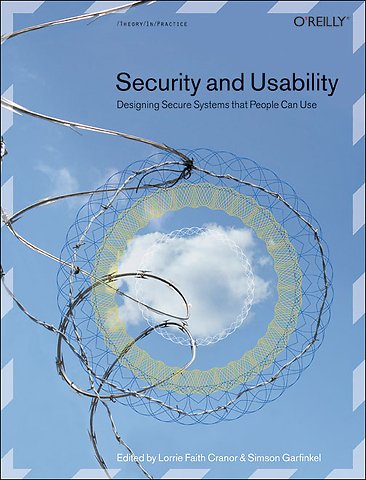


Lorrie Faith Cranor is an Associate Research Professor in the School of Computer Science and in the Engineering and Public Policy Department at Carnegie Mellon University.
Meer over de auteursSecurity and Usability
Designing Secure Systems that people can use
Samenvatting
Human factors and usability issues have traditionally played a limited role in security research and secure systems development. Security experts have largely ignored usability issues-both because they often failed to recognize the importance of human factors and because they lacked the expertise to address them.
But there is a growing recognition that today's security problems can be solved only by addressing issues of usability and human factors. Increasingly, well-publicized security breaches are attributed to human errors that might have been prevented through more usable software. Indeed, the world's future cyber-security depends upon the deployment of security technology that can be broadly used by untrained computer users.
Still, many people believe there is an inherent tradeoff between computer security and usability. It's true that a computer without passwords is usable, but not very secure. A computer that makes you authenticate every five minutes with a password and a fresh drop of blood might be very secure, but nobody would use it. Clearly, people need computers, and if they can't use one that's secure, they'll use one that isn't. Unfortunately, unsecured systems aren't usable for long, either. They get hacked, compromised, and otherwise rendered useless.
There is increasing agreement that we need to design secure systems that people can actually use, but less agreement about how to reach this goal. Security & Usability is the first book-length work describing the current state of the art in this emerging field. Edited by security experts Dr. Lorrie Faith Cranor and Dr. Simson Garfinkel, and authored by cutting-edge security and human-computer interaction (HCI) researchers world-wide, this volume is expected to become both a classic reference and an inspiration for future research.
Security & Usability groups 34 essays into six parts:
- Realigning Usability and Security---with careful attention to user-centered design principles, security and usability can be synergistic.
- Authentication Mechanisms-- techniques for identifying and authenticating computer users.
- Secure Systems--how system software can deliver or destroy a secure user experience.
- Privacy and Anonymity Systems--methods for allowing people to control the release of personal information.
- Commercializing Usability: The Vendor Perspective--specific experiences of security and software vendors (e.g., IBM, Microsoft, Lotus, Firefox, and Zone Labs) in addressing usability.
- The Classics-groundbreaking papers that sparked the field of security and usability.
This book is expected to start an avalanche of discussion, new ideas, and further advances in this important field.
Specificaties
Inhoudsopgave
Part. Realigning Usability and Security
1. Psychological Acceptability Revisited
Matt Bishop
2. Usable Security
M. Angela Sasse and Ivan Flechais
3. Design for Usability
Bruce Tognazzini
4. Usability Design and Evaluation for Privacy and Security Solutions
Clare-Marie Karat, Carolyn Brodie, and John Karat
5. Designing Systems That People Will Trust
Andrew S. Patrick, Pamela Briggs, and Stephen Marsh
Part. Authentication Mechanisms
6. Evaluating Authentication Mechanisms
Karen Renaud
7. The Memorability and Security of Passwords
Jeff Yan, Alan Blackwell, Ross Anderson, and Alasdair Grant
8. Designing Authentication Systemswith Challenge Questions
Mike Just
9. Graphical Passwords
Fabian Monrose and Michael K. Reiter
10. Usable Biometrics
Lynne Coventry
11. Identifying Users from Their Typing Patterns
Alen Peacock, Xian Ke, and Matt Wilkerson
12. The Usability of Security Devices
Ugo Piazzalunga, Paolo Salvaneschi, and Paolo Coffetti
Part. Secure Systems
13. Guidelines and Strategies for Secure Interaction Design
Ka-Ping Yee
14. Fighting Phishing at the User Interface
Robert C. Miller and Min Wu
15. Sanitization and Usability
Simson Garfinkel
16. Making the Impossible Easy: Usable PKI
Dirk Balfanz, Glenn Durfee, and D.K. Smetters
17. Simple Desktop Security with Chameleon
A. Chris Long and Courtney Moskowitz
18. Security Administration Tools and Practices
Eser Kandogan and Eben M. Haber
Part. Privacy and Anonymity Systems
19. Privacy Issues and Human-Computer Interaction
Mark S. Ackerman and Scott D. Mainwaring
20. A User-Centric Privacy Space Framework
Benjamin Brunk
21. Five Pitfalls in the Design for Privacy
Scott Lederer, Jason I. Hong, Anind K. Dey, and James A. Landay
22. Privacy Policies and Privacy Preferences
Lorrie Faith Cranor
23. Privacy Analysis for the Casual User with Bugnosis
David Martin
24. Informed Consent by Design
Batya Friedman, Peyina Lin, and Jessica K. Miller
25. Social Approaches to End-User Privacy Management
Jeremy Goecks and Elizabeth D. Mynatt
26. Anonymity Loves Company: Usability and the Network Effect
Roger Dingledine and Nick Mathewson
Part. Commercializing Usability: The Ventor Perspective
27. ZoneAlarm: Creating Usable Security Products for Consumers
Jordy Berson
28. Firefox and the Worry-Free Web
Blake Ross
29. Users and Trust: A Microsoft Case Study
Chris Nodder
30. IBM Lotus Notes/Domino: Embedding Security in Collaborative Applications
Mary Ellen Zurko
31. Achieving Usable Security in Groove Virtual Office
George Moromisato, Paul Boyd, and Nimisha Asthagiri
Part. The Classics
32. Users Are Not the Enemy
Anne Adams and M. Angela Sasse
33. Usability and Privacy:A Study of KaZaA P2P File Sharing
Nathaniel S. Good and Aaron Krekelberg
34. Why Johnny Can't Encrypt
Alma Whitten and J. D. Tygar
Index
Anderen die dit boek kochten, kochten ook
Net verschenen
Rubrieken
- aanbestedingsrecht
- aansprakelijkheids- en verzekeringsrecht
- accountancy
- algemeen juridisch
- arbeidsrecht
- bank- en effectenrecht
- bestuursrecht
- bouwrecht
- burgerlijk recht en procesrecht
- europees-internationaal recht
- fiscaal recht
- gezondheidsrecht
- insolventierecht
- intellectuele eigendom en ict-recht
- management
- mens en maatschappij
- milieu- en omgevingsrecht
- notarieel recht
- ondernemingsrecht
- pensioenrecht
- personen- en familierecht
- sociale zekerheidsrecht
- staatsrecht
- strafrecht en criminologie
- vastgoed- en huurrecht
- vreemdelingenrecht





